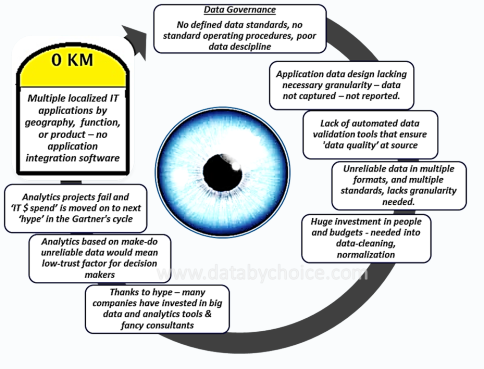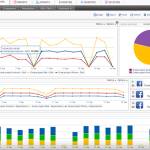Towards a Data-driven Organization: A Roadmap for Analytics

Building a Data-driven Organization requires identifying and prioritizing the opportunities where advanced analytics can make a material difference to the quality of decisions!
I was one of those fortunate few to have an opportunity to work on both sides of the table, both as a provider of services and as a consumer of technology and business services. A few years back when I was working on the other side of the table, I have been asked to explore setting-up an analytics lab to support decision makers in different BUs and Functions.
I went through the first few preparatory steps of taking stock of BI-DW practices across the locations, data availability, and data quality, key analytics requirements as per existing practices. Next, I attempted the ever-difficult task of talking to some of the stake-holders on what they expect from an Analytics Lab. Their reactions varied from “you first-make-our-IT-systems-work” to “do-we-ever-get-the-data we need, when-we need-it”.
When asked about the time they spend on creating a report vs. analyzing a report; one of the more vocal feedback was: “Reports are usually made because we are asked to submit them for reviews. We spend 99% of the time chasing the data, 1% in creating a report barely managing to submit it before deadline, we rarely ever get the time to review and analyze a report”.
I have persisted and pestered a willing-few to list out the specific data-analytics requirements to support their decisions. To cut to chase, I did not have much success. While some drew a blank, many have given me a list of everything … “After all we don’t know what the Board is likely to ask me in my review…”
I tried some of the market leading analytics firms next. “If you tell us the problem you are trying to solve, we will collect the data from your multiple applications, clean and normalize the data, then run analytics on top of them.”Not one to give up easily, I decided to seek help from consulting companies to help me understand the way forward. I called the usual suspects, and as per usual, they were more than willing to do a due-diligence to suggest a way forward. “You see…we will start with all BI reports, consolidate the reports based on actual usage statistics & add analytics on top of them.” Somehow, starting from existing BI reports did not sound right to me.
I attempted to convince them that I need a Master-Plan to identify all opportunities for Advanced Analytics, Create a Roadmap for converting the company into a data-driven organization, & a Business-Case with cost-benefit. I was keen on identifying “all the opportunities” for data-driven decision-making in the organization. But sadly, there were no takers.
For some of you, the story must be familiar. While value from analytics in areas such as Retail, Fraud Detection, Customer Acquisition etc. is now unquestionable, Gartner still mentions only 30% of all analytics initiatives deliver some business value. Gartner also mentions that investment into Advanced Analytics is now considered a survival necessity for organizations to compete in increasingly digitized market place.
However, most CXOs we have talked to think that the very idea of Data-driven Organization is far-fetched and too big a leap from where they are currently. Some told us they are yet to see results from their SAP Business Objects / Business Intelligence investments. Most admit they seldom know “what data” they need prior to an important meeting, and hence ask for “as much data” as they can get.
On the other hand, CIOs complain that “satisfaction” of the business is an ever-moving target and their internal customers seldom know what they want. Some CIOs mentioned that they produce hundreds of customized-reports, most of which are rarely used by the business.
So there lies the challenge of investing into Advanced Analytics and making it work, and deliver value.
Defining Data-Driven Decision Making
In their 2012 HBR feature on big data, Andrew McAfee and Erik Brynjolfsson describe the opportunity and report that “companies in the top third of their industry in the use of data-driven decision making were, on average, 5% more productive and 6% more profitable than their competitors” even after accounting for several confounding factors.” The same article further quotes “The evidence is clear: Data-driven decisions tend to be better decisions. Leaders will either embrace this fact or be replaced by others who do.”
Whatis.techtarget.com defines Data-driven Decision management (DDDM) as “an approach to business governance that values decisions that can be backed up with data that can be verified. Data-driven decision management is usually undertaken as a means of gaining a competitive advantage”.
From my own experience, the key word that is usually not given the importance it deserves is “data”. The decision can only be as good as the data that is supporting it.
Decision Oriented Analytics: From Decisions, To Data
I have subsequently tried to find out if there was someone who has thought through this problem earlier. Surprisingly, there were very few references. The one I found closer to my thought process was from James Taylor of Decision management Solutions. While I am yet to read his book (Smart Enough Systems: How to Deliver Competitive Advantage by Automating Hidden Decisions, James Taylor and Neil Raden), I have read a SAS white paper quoting the book on the importance of starting with the “decision in mind”. The paper quotes “Some decisions are major (e.g., which countries to do business in), and some are minor (e.g., what to offer as a cross-sell to a customer on the phone).” The same SAS white paper also quotes another book, The 7 Habits of Highly Effective People, by Stephen Covey which apparently advocates “begin with the end in mind.”
The two conclusions I have arrived at –
- While the SAS Whitepaper does not mention this exactly, it reinforces the method I often use for data-design – “Deriving the Data Definitions from the Decision Making Criteria (Variables / Constraints)”. Identifying and prioritizing decisions will have to be the necessary first step for any Organization embarking on a journey to become a data-driven organization.
- The next step is to identify the data behind each of these shortlisted business critical decisions; meaning identifying the data required for supporting each of the decisions, the data-gap & data-sourcing strategy. Further, for meaningful Analytics, Data needs to be captured in the required form, format & with appropriate level of granularity.
So what’s missing with traditional thinking associated with Analytics?
Allow me to explain myself further. Consider the typical “Analytics Process” as practiced by most Analytics consulting firms. Most of them refer to Analytics Process (Fig.) explained as “the process that goes into making raw-data into interactive analytics” that a Decision maker could use. Perfectly logical, and all most all Analytics companies apply the same logic: “Give me your data, and we will try and bring out some insights out of it”.
To me, the very idea of starting from “data” appeared to be error-prone. While one may still find a few ‘actionable insights’ not linked to specific identified organizational decisions, I would expect such insights to be non-significant assuming we have identified and prioritized all the decisions that make a material difference to the organizational performance. The ideal approach should have been to reverse the flow.
Reversing the flow: Deciphering the Data behind the Decisions
- Start from the Decision, and the workout “the data behind the decision and the gaps”.
- Workout “what data with what granularity” needs to be captured at transaction-level from different transactional IT Applications!
Unlike the traditional approach, this process helps us in identifying the “data gaps” behind the decision, and in creating a “data sourcing strategy” for missing data.
Problem vs. Opportunity Mindset
Most Analytics companies start off with ‘a problem’ that customer has identified himself, and work out a solution, usually and Excel based analysis and Insights – based on ‘data’ collated as on ‘a date’ and normalized.
Referring to my “Original Need” – I was actually looking for someone to help me identify “all the Advanced Analytics opportunities” in the company and Create a Roadmap for converting the company into a Data-driven Organization. I was seeking help from a (any) consulting company to help me identify all the opportunities and lay down a ‘Priority Roadmap” for Advanced Analytics based on Business Criticality of the Decision & the size of the prize ($$).
The concept of point-fixing a solution to “a problem” presupposes that the system is already at its peak productivity and hence one need not look for further opportunities to optimize cost and cycle time.
On the other hand, Opportunity focused Analytics roadmap would involve identifying all opportunities where Analytics can help improve the efficiency of the process.
The process flows are depicted in the picture above.
Point VS. Permanent Solutions
The other notable observation from the picture above, most Analytics solutions ‘stop’ at being an Excel based one-time analysis & recommendation for action – rather than a permanent solution for generating real-time analytics, insights, EWS, Alerts etc.

The single biggest reason for the above is ‘the inconsistency’ in the way ‘data’ has been defined, and captured in different source IT applications, especially in the absence of an MDM (Master Data Management) module. The net result being same data would have different definitions, different standards, different formats, and different granularity in each of the source system – making automated integration extremely difficult.
Good many of the corporate decisions tend to-be ‘repetitive’ by nature, and only a real-time Advanced Analytics solution can provide the timely insights reflecting the ‘ever-changing scenarios’. More on this in the next section.
Big-Data for Big-Decisions
Now to the core of all questions! Having concluded that one needs to “start from decisions”, how does one decide which specific decision needs to supported by ‘Advanced Analytics’ first and what would be the relative priority? Fortunately, the logic is simple enough for everyone’s understanding. One obviously needs to select decisions based on the Relative Business Value – as measured by the Business criticality of the Decision & the Size of the prize ($$$).
Over the last one year, with the support of my colleagues at Data-by-Choice, we have created a Comprehensive Methodology for prioritizing Organizational decisions based on a holistic set of parameters, which not just takes into account the $$ value of the decision, but also the cumulative-number of times the decision is taken in a year.
For example a decision on how much of buffer-stock to keep in each of the ware houses may be individually a small value ($$) decision, but collectively across locations and cumulative over the year, it could be the most important organizational decision affecting the bottom-line of the company.
Hence, the first-phase of our consulting-engagements typically involves identifying 10% of the decisions that influence 90% of the organizational outcomes. The second phase involves working out analytics solutions that could substantially improve the quality of each of the identified decisions.
This article taken from http://datasciencecentral.com

Kalyan Banga226 Posts
I am Kalyan Banga, a Post Graduate in Business Analytics from Indian Institute of Management (IIM) Calcutta, a premier management institute, ranked best B-School in Asia in FT Masters management global rankings. I have spent 14 years in field of Research & Analytics.
















1 Comment
8 Beginner Analytics Blogger Mistakes to Avoid - Fusion Analytics World
December 5, 2016 at 12:21 pm[…] instance, if you are offering analytical services to businesses, you can share on your blog anything and everything that revolves around this. […]